 |
Alexander
Graham Bell (1847 - 1922)
Bell was
born in
Edinburgh.
His invention of the telephone was in pursuit of a device to help the deaf. He
patented his early telephone in February 1876 - only days ahead of other
rivals. He formed the Bell Telephone company in 1877 and became rich as a
result. He was also involved in genetics and invented a new method of sheep
breeding.
|
 |
Robert
Burns (1759 - 1796)
Poet. Robert
Burns was born in the
village of
Alloway
in
Ayrshire. For much of his life he was involved with the land and physical
toil and knew well the difficulties of poverty and deprivation. Nevertheless,
as a young man he had taken to writing poetry, much of it in his native Scots
language. This was unusual - by the end of the 18th century Scots was no longer
regarded as the speech of "educated" men and women. In 1786 he was about to emigrate
to the
West Indies when he
published a collection of his poems in the county town of
Kilmarnock -
"Poems, Chiefly in the Scottish Dialect". The book (now known as the
Kilmarnock Edition) was an instant success and instead of emigrating he went to
Edinburgh where
he was welcomed by a number of leading literary figures. The money he earned
firstly allowed him to travel. During his journeys he was to collect and edit
many of the almost forgotten songs and, of course, obtain inspiration for
further poetry. Despite the money which he earned from his poems, he still had
to make a living by being both a farmer and an excise officer in
Dumfries.
While trying to cultivate an unproductive farm and carry out his duties as an
excise man, he continued to write - mainly collections of songs which would
otherwise have been lost forever.
|
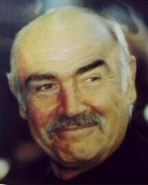 |
Sir Sean Connery (1930 - )
Actor. Regarded
by some as the greatest president
Scotland never
had, Sean Connery was born in the Fountainbridge area
of
Edinburgh. This
was a poor area of the city and his father was a lorry driver and his mother
earned a few shillings as a tea lady. Sean helped the family finances by
working as a milk delivery boy from the age of 9 to 13. He left school at age
13 and became a brick layer, a bouncer and a French polisher before he joined
the Merchant Navy. Keen on body building, he entered the Mr Universe contest in
London in
1953 and came third. That led to some small acting parts on stage and in films.
Over the next five years he appeared in a number of minor roles. Then he played
in seven James Bond films. He also starred in "The Hill",
"Highlander", "Indiana Jones and the Last Crusade" and an Oscar
winning performance as best supporting actor as a Chicago cop in "The
Untouchables".
|
 |
David Marshall Coulthard (1971 - )
Grand
prix racing driver. Coulthard was
born in
Dumfries, brought up in Twynholm and educated at
Kirkcudbright
Academy. He
started his racing career in gokarting at the age of
eleven, becoming Scottish Junior Karting Champion. He
moved up through Formula Ford and Formula 3, to become a Formula 1 driver in
1994. In the same year he was recognised as Scottish Sports Personality of the Year. Coulthard
recorded 10 wins for the McLaren team between 1994
and 2003 and now lives in
Monte Carlo.
|
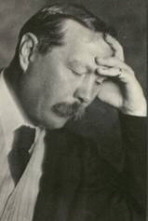 |
Sir Arthur Conan Doyle (1859 - 1930)
One of seven children, Doyle was
born the son and grandson of artists (his grandfather was a political
cartoonist in "Punch" magazine). He studied medicine at
Edinburgh
University.
After a spell as ship's surgeon on a whaling ship, he worked as a doctor from
1882-90 in practices in Southsea and
London. But
the success of his early fiction encouraged him to give this up and devote
himself to writing. In 1896 Doyle became a war correspondent in the
Sudan and
he served as a doctor in the 1899-1902 Boer War in
South
Africa. He was knighted
in 1902 for his service in the war. He wrote a history of the Boer War. His
interest in spiritualism became known during World War I and he wrote a number
of books on the subject. In 1927 the Sherlock
Holmes stories were published as "The Case-Book of Sherlock Holmes."
|
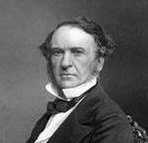 |
William Ewart Gladstone (1809 - 1898)
Although born in
Liverpool,
Gladstone was
always quick to point to his two Scottish parents and that "not a drop of
blood in my veins is not Scottish." He entered parliament in 1832 and he
served a record 61 years in the House of Commons, becoming
Prime Minister on no less than four
occasions - the last at the age of 82. As
Chancellor of the Exchequer he was noted for simplifying the tax system. He had
a gift for public speaking and in a famous election campaign in
Midlothian in
1879 an estimated 20,000 people heard him speak. His great political rival for
many years was Benjamin Disraeli.
Gladstone is
buried in Westminster Abbey.
|
 |
David Hume (1711 - 1776)
Born
in
Edinburgh into a Calvinist family. Hume entered
Edinburgh University at the age of 12(!) to study law, leaving less than
three years later, having concentrated more on his own interests than his
course work. After a brief business career in
Bristol, he
moved to
France and
took up writing. His development of philosophical ideas had been influenced by
the concepts of science and observation. In addition to writing books on
philosophy which have influenced
thinking to this day, Hume also wrote a number of books of history, including
works on the reigns of King James VI and Charles I and also a "Natural
History of Religion". A recent poll of academics voted Hume as the Scot
who had made the greatest impact on
Scotland in
the last 1,000 years.
|
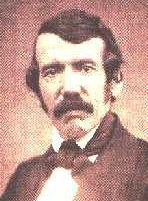 |
Dr David Livingstone (1813 - 1873)
David Livingstone
was the son of a shopkeeper. He started work at the age of 10 but nevertheless
managed to educate himself and to study medicine and theology at
Glasgow
University to
become a missionary doctor. He
arrived in
Bechuanaland in
1841 and married the daughter of another missionary there. Livingstone began to
explore uncharted areas of
Africa and
while mapping the upper
Zambesi
River he
discovered the
Victoria Falls.
Livingstone almost died several times from disease and eventually succumbed in
1873, having refused to return to
Britain. His
embalmed body was brought back and was buried in Westminster Abbey.
|
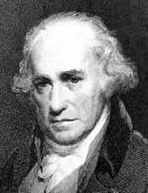 |
James Watt (1736 - 1819)
Watt suffered
from poor health and did not attend school regularly. Instead, he spent time in
his father's workshop, learning engineering skills and making models. He trained
as an instrument maker and in 1757 obtained a post at
Glasgow
University.
Watt never stopped inventing right up to his death and he created a
steam locomotive, a chemical document
copier, advised Josiah Wedgewood on pottery
processes, surveyed the Caledonian and Forth and Clyde Canals and deepened both
the rivers Clyde and Forth. He also gave his name to the Watt unit of power and
introduced the term "horsepower". But it is Watt's development of the
steam engine, which was the springboard for the Industrial Revolution, for
which he is rightly famous.
|
 |
John Knox (1513 - 1572)
John Knox was
born in Haddington, a town not far from
Edinburgh,
and he went to university there, briefly, before starting work as a lawyer. In
1546 he supported the murder of David Beaton,
Archbishop of St Andrews, and was imprisoned for 18 months on a French galley
(The French Mary of Guise, widow of James V, was Regent of Scotland at
this time). After his release he travelled extensively, gaining favour at the
English court of the Protestant King Edward VI. While
in
Geneva, he was influenced by the ideas of Calvin. Knox
came back to
Scotland in
1559 and became minister at St Giles in
Edinburgh. In
1560 the Scottish Parliament, with guidance from Knox, drew up the
"Confession of Faith" which
established Protestantism in the Church of Scotland along the lines he
had learned in
Geneva. The
Catholic Mary Queen of Scots returned from
France in
1561 and she was subjected to an unrelenting onslaught from Knox. A powerful
orator with a dogmatic style, he believed in a rigorously disciplined life.
|
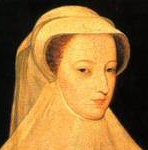 |
Mary Queen of Scots (1542 - 1587)
The daughter of
King James V and his second wife, Mary of Guise, was born at
Linlithgow
Palace on
8 December 1542.
James had been wounded at the defeat of the Scots army at the Battle of Solway
Moss
(1542) and he died six days after the birth of his daughter.
Mary was crowned
at
Stirling
Castle on
9 September 1543.
Under the guardianship of the 2nd Earl of Arran, the infant Mary was betrothed
to the son of King Henry VIII of
England.
However, a pro-Fench and Catholic faction led by
Mary's mother, Mary of Guise, gained the ascendancy and the agreement was
overturned. King Henry VIII sent an army into
Scotland to
enforce the marriage in what became known as the "Rough Wooing". Mary
was sent for safety to
France (with
her mother, Mary of Guise and her four childhood friends - the "Four Marys") where she married the Dauphin, the heir to
the French crown, in 1558. She became Queen of France and
Scotland in
1559 but her husband, King Francis II, died in 1560. Mary returned to
Scotland
despite the Protestant faith gaining official status. Mary was by now the heir presumptive of
England, following the death of Henry VIII and the accession of Queen Elizabeth
I. During Mary's reign she was attacked for her Catholic beliefs by the
Protestant religious reformer John Knox. Despite other potential marriages
(including the Roman Catholic heir to the Spanish throne) she married her first
cousin, Henry Stewart, Lord Darnley, after a
whirlwind courtship, in July 1565. Darnley was an
arrogant man who alienated many of the Scottish nobles. He was also a member of
the group which murdered David Rizzio, Mary's
secretary, in
Holyrood
Palace in
1566, in the presence of Mary. The future James VI was born a few months
later. Darnley was murdered in 1567 and the Earl of Bothwell was accused - but acquitted - of the crime. A few
months later Mary and Bothwell were married. Scandalised
nobles imprisoned Mary in
Loch Leven
Castle and
she was forced to abdicate in favour of her son, James VI. Mary escaped from
Loch Leven in
May 1568 but was defeated at the Battle of Langside
on 13 May. She escaped to
England but was imprisoned by Queen Elizabeth I
who saw her as a threat to her throne. A focus for
Catholic plots, some of which were aimed at making Mary the Queen of England, she was beheaded
at
Fotheringay
Castle on
18 February 1587.
|
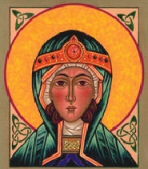 |
St Margaret (1046 - 1093)
Margaret was a
descendant of King Alfred. Her father, Edward, was exiled during the reign
of King Canute and he had a Hungarian wife from
the Hungarian royal family. Margaret was
born in
Hungary. Her
brother had a claim to the throne of
England but
came to terms with William the Conqueror. Margaret was very pious, caring for
the poor and orphans and damaged her own health by repeated fasting and
abstinence. She married the Scottish king, Malcolm Canmore who made Edinburgh
the new capital of the country. She is said to have been the inventor of
the Scottish tartan pattern ("mother of tartans"). In 1093, as she lay on her deathbed after a long illness, she was
told that her husband and eldest son had been ambushed and killed at the Battle
of Alnwick, Northumbia. She
thanked God for the pain this had brought her as it might cleanse her own sins
and breathed her last. She is one of the patron saints of Scotland.
|
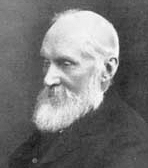 |
William Thomson - Lord Kelvin (1824 - 1907)
Born in
Belfast,
Thomson came to
Glasgow at
the age of six after the death of his Scottish mother and when his father
became Professor of Mathematics at the
University of
Glasgow.
He was taught by his father (he never went to school) and entered University at
the age of 10 (and is in the Guiness Book of Records
for that feat). By the age of 22 he had been to
Cambridge and
Paris
Universities and
was appointed Professor of Mathematics and Natural Philosophy at
Glasgow
University. He
developed the science of thermodynamics,
the second law of thermodynamics and formulated the
"Kelvin" scale of absolute
temperature. Kelvin published 660 scientific papers, the first at age 16.
But he was not just an academic scientist - he was a champion rower and founded
the Glasgow University Music Society.
|
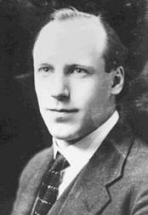 |
Eric Henry Liddell
(1902 - 1945)
Record-breaking
runner who won two medals in the 1924
Paris Olympic Games. Although born in
Tientsin,
North China, where his
parents were missionaries, and schooled in
London, the family home
was in
Edinburgh. Liddell attended
the
University of
Edinburgh, where he began
to run competitively. He went to the Paris Olympics to run in the 100m, but
refused to take part in this race, due to his religious principles, because the
qualifying heats were held on a Sunday. However, he was able to run in the
200m, winning a bronze medal and was persuaded to enter the 400m,
a distance in which he had little experience, yet sensationally won the gold
medal. He returned to
China as a missionary
in 1925, where he died in a Japanese internment camp. His achievements are
remembered in the 1981 film Chariots of Fire.
|
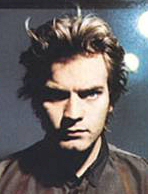 |
Ewan Gordon MacGregor
(1971 - )
Actor. Born in Crieff and educated at
Fife
College in
Kirkcaldy, MacGregor has acted in over 25 films since
1993. He came to the fore in the black drama Shallow Grave (1994). Further success came with Trainspotting
(1996), portraying
Edinburgh's drug under-culture, as
well as the role of
Obi-Wan Kenobi in the Star
Wars revisit The Phantom
Menace (1999) and subsequently in Episodes II and III.
|
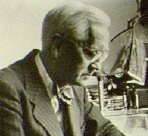 |
Sir
Alexander Fleming (1881 - 1955)
Medical Scientist. Born at Lochfield Farm near Darvel, East Ayrshire, where he is commemorated by a monument
in the town square. Fleming was educated in Darvel
and
Kilmarnock, before moving
to
London where
he entered St. Mary's
Medical
School in
the
University of
London. In
1928, he discovered the world's first
antibiotic drug - Penicillin. This was as a result of an
"accident" where mould was allowed to grow on a bacterial culture. In
the same year, he was appointed to a Chair in St. Mary's
Medical
School. A
prodigious scientist, Fleming was widely honoured, including a knighthood
(1944) and the Nobel Prize for Medicine (1945). Fleming is buried in
St.
Paul's Cathedral (London).
|
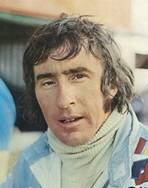 |
Sir John (Jackie)
Young Stewart (1939 - )
Racing
car driver. Stewart was born in Dumbarton, and educated at the
Academy in that town. He was the son of a Jaguar car dealer, and began as a
mechanic in his father's garage. Stewart went on to become
Britain's
most successful Formula One driver,
winning the World
Championship on three occasions (1969, 1971 and 1973). With 27 race
wins, he beat the record established by another noted Scottish racing driver,
Jim Clark (1936-68). Stewart's record was not equalled for another 14 years.
Stewart was also an Olympic-class clay pigeon shooter. In 1997, together with
his son, Stewart launched his own Formula One motor racing team. The team was
sold to the Ford Motor Company three years later for $96 million and renamed
Jaguar Racing. Stewart was knighted in the Queen's Birthday Honours List in
2001.
|
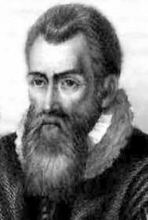 |
Sir John Napier
(1550 - 1617)
Mathematician, inventor and
astronomer. Born at
Merchiston
Castle
(Edinburgh)
into a wealthy family. He was educated at St. Salvator's
College,
St. Andrews and became a staunch
Calvinist. He devised "Napier's Rods" which permitted easy
multiplication by addition. This led to his best remembered work: the
concept of logarithms. He also invented
the decimal point and a hydraulic
screw pump to remove water from coal mines. Napier also proposed a number of
new weapons, including a device based on mirrors to set fire to enemy ships by
focussing a high-intensity light beam, an armoured wagon and a submarine. He
experimented in agricultural improvement on his estates. Napier, the genious, was buried at St. Cuthbert's Church in
Edinburgh.
|
 |
Sir
William Ramsay (1852 - 1916)
Chemist. Ramsay
was born in
Glasgow and
became Professor of Chemistry at
Bristol and
then
University
College,
London. Chiefly responsible for the
discovery
of the rare gases Argon (1894), Helium (1895), Neon, Krypton and Xenon
(1898). Also worked in radioactivity. He spread
scientific interest to other parts of the
British Empire,
including setting up the Indian Institute for Science at
Bangalore. He
was knighted in 1902 and received a
Nobel
Prize for Chemistry in 1904.
|
 |
Keir Hardie (1856 -
1915)
British
politician, born near Holytown,
North Lanarkshire. He
worked in the mines between the ages of 7 and 24, and was victimized as the
miners' champion. He became a journalist and the
first Labour Member of Parliament in 1892. He founded and edited
the Labour Leader, and was chairman of the Independent Labour Party (founded
1893). Instrumental in the establishment of the Labour Representation
Committee, he served as chairman of the Labour Party (1906-8). His strong
pacifism led to his becoming isolated within the Party, particularly once World
War I had broken out.
|
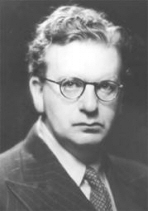 |
Logie Baird (1888 - 1946)
Electrical
engineer and television pioneer,
born in Helensburgh, Argyll and
Bute. He
studied electrical engineering at
Glasgow
University,
later settling in
Hastings (1922),
where he began research into the possibilities of television. In 1926 he gave
the first demonstration of a television image. His 30-line mechanically scanned
system was adopted by the BBC in 1929, being superseded in 1936 by his 240-line
system. In the following year the BBC chose a rival 405-line system with
electronic scanning made by Marconi-EMI. Other lines of research initiated by
Baird in the 1920s included radar and infra-red television (Noctovision);
he also succeeded in producing three-dimensional and coloured images (1944), as
well as projection onto a screen and stereophonic sound.
|
 |
James Maxwell (1831 - 1879)
Physicist, born in
Edinburgh. He studied at
Edinburgh and
Cambridge,
became professor at
Aberdeen
(1856) and
London
(1860), and was the first professor of experimental physics at
Cambridge
(1871), where he organized the Cavendish Laboratory. In 1873 he published his
great Treatise on Electricity and Magnetism, which gives a mathematical
treatment to Faraday's theory of electrical and magnetic forces. He also
contributed to the study of colour vision, and to the kinetic theory of gases,
but his greatest work was his theory of
electromagnetic radiation (it is the foundation for telecommunications:
radio, TV, cell phone), which established him as the leading theoretical
physicist of the century.
|
 |
Sir Walter Scott (1771 - 1832)
Novelist and poet, born in
Edinburgh. He
studied in
Edinburgh,
trained as a lawyer (1792), and began to write
ballads in 1796, though his first major publication did not appear
until 1802: The Border Minstrelsy. His ballads made him the most popular author
of the day, and were followed by other romances, such as The Lady of the
Lake
(1810). He then turned to
historical
novels, which fall into three groups: those set in the background of
Scottish history, from
Waverley
(1814) to A Legend of Montrose (1819); a group which takes up themes from the Middle Ages and Reformation times, from Ivanhoe (1819) to
The Talisman (1825); and his remaining books, from
Woodstock (1826) until his death.
He was created a baronet in 1820. He did much to revive interest in all
things and places Scottish both at home and in England.
|
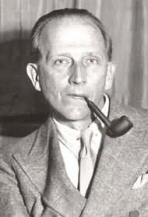 |
Alan Alexander Milne (1882-1956)
also known as A. A. Milne, best known for his books about
the teddy bear, Winnie-the-Pooh, and for various children's poems. Milne was a
noted writer, primarily as a playwright, before the huge success of Pooh
overshadowed all his previous work.
|























